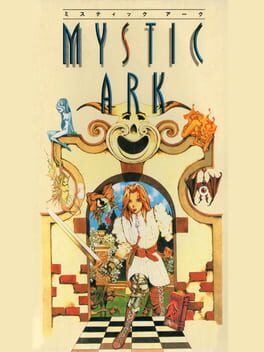Produce's Mystic Ark effectively updates an old RPG idea: What used to be the 'Examine' command (a menu-based function that searches for pickups/NPCs in the player's direction, later replaced by the interact button) is now a full-fledged system. Also found in their previous Elnard (from which they also inherited its radar-map encounters), this time the feature is used not only for collecting items, investigating objects and talking, but also for matching the former with the second to make progress. Not surprisingly, their gameplay is more puzzle-oriented than the average JRPG. Its dungeons compose a decent overview of adventure game techniques (push blocks, levers, crumbling-floor traps, etc.), but the quirky levels, the wealth of creative and funny moments, and the equally complex hub world made their method quite unique. Plenty of tasks are just tricky enough to require a bit of experimentation and thinking (or guides), but rarely do they leave the player directionless.
Combat - instead, isn't nearly as brainy nor exciting; turn-based frontview battling that would have felt outdated even in '95, despite improving over Elnard in many ways (notably the addition of modular auto-tactics and a range of skills across both magic and attack commands). Sometimes they lapse into mazes or standard trials, and the pacing & menus resemble that of old-school crawlers. But across its towns, scenarios (check out the brilliant 'haunted-house-with-environmental-puzzles' of act 6), enemy designs, gameplay variety (including monster capture and minigames), QoL (minimizing backtracking burnout by allowing fast travel from virtually anywhere), characters, cutscenes and graphics, Produce shows remarkable progress.
This work, along with the more Zelda-rooted Lufia 2 (and Wild Arms to an extent), were the JRPGs that upheld adventure game traditions in an era that favored storytelling and combat, which - arguably, were much easier ways to inflate the runtime.
Combat - instead, isn't nearly as brainy nor exciting; turn-based frontview battling that would have felt outdated even in '95, despite improving over Elnard in many ways (notably the addition of modular auto-tactics and a range of skills across both magic and attack commands). Sometimes they lapse into mazes or standard trials, and the pacing & menus resemble that of old-school crawlers. But across its towns, scenarios (check out the brilliant 'haunted-house-with-environmental-puzzles' of act 6), enemy designs, gameplay variety (including monster capture and minigames), QoL (minimizing backtracking burnout by allowing fast travel from virtually anywhere), characters, cutscenes and graphics, Produce shows remarkable progress.
This work, along with the more Zelda-rooted Lufia 2 (and Wild Arms to an extent), were the JRPGs that upheld adventure game traditions in an era that favored storytelling and combat, which - arguably, were much easier ways to inflate the runtime.
